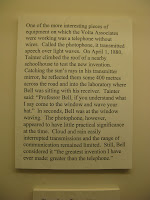When I first planned out this trip I got a lot of AAA books to check out things to see in each place that we stopped and I wanted to make sure that I found things that would interest Karl because he's been to most of the provinces except for PEI and Nova Scotia. So I found things that would interest him and me both. Now PEI, if we really wanted to, could have taken us two days to see. Not because of the size but because of the timing and what we wanted to see. Nova Scotia on the other hand is a different story. Neither of us realized how much driving we would have to do to see things on this peninsula. It would take us about 3-4 days to see all we wanted and that's because of all the driving. So we sat down and re-analyzed our desires. After taking a hard look at what we highlighted we were able to take out a few things because we have done things like them at other places. That left us with four places to see - two on the southwestern end and two at the northeastern end. The problem? The "ends" are about 9 hours apart! So we are spending the night in Nova Scotia and cutting the peninsula in half.
Today we took in the southwestern end and visited a beautiful little village called Peggy's Cove. It's a very small (only 35 year round residents) village that the people make a living lobster harvesting. But during the season thousands descend on this place. The cove is a picture postcard with craggy coastline, lobster boats in the cove, small homes and a lighthouse. We had lunch at a great place called the Sou'wester and there I finally had my lobster roll. It was worth the wait. While we were there tour buses showed up to let their passengers off. It's amazing the number of people that come here in this desolate area. But it was well worth the drive.
We drove back into Halifax (typical large capital city) to go to the Maritime Museum of the Atlantic. This was a very good museum showing how the sea is an intricate part of life on Nova Scotia. On the first floor they showcase the Canadian Navy and different sail boats that have been donated to the museum. That was okay, but to me the second floor was much more interesting. There you had displays of shipwrecks and the artifacts they have recovered. The most exciting display was one on the Titanic. They had stories and artifacts from the doomed ship. It was rather sobering seeing things that were recovered and you knew that people once held those items or wore those items.
The next day we took off from Halifax to drive northeast to see our destinations up there. About 70 miles outside of Halifax we noticed a commonality in street names: MacDonald, MacInnis, MacIntyre, Campbell, Ross and in town names: Inverness, St. Andres, Invernary, Glendale, Glencoe. See similarities here? All of a sudden we are into the heart of New Scotland. Even signs are in Gaelic! The areas opened up more and you could see the countryside. A lot of Scots landed there because it reminded them of home. Our first stop was at a living history area called Highland Village Museum. It was like Fort William was in Thunder Bay, but more people were there at the village. They get a lot of cruise ships docked in Sydney, about an hour north, and tour buses bring them there so they are open until the end of October. They have recreated a Scottish village and moved buildings there that would have been used by the immigrants as the years went by. The only buildings that weren't original were the stone soddy house (the first house they would have built) and the log house which would have been the second house they built. Every one else was moved from a previous location in the area to be preserved to the village to be preserved. Another place I would have loved to have seen during the "season".
Our last stop was at the Alexander Graham Bell Centre. Here they told the story of his life and inventions besides the telephone. They had artifacts, photos and stories about him and his family. Here are some things we found out that we never knew: His father, being interested in speech and audiology, created the first visual speech system; his mother was practically deaf; his wife was completely deaf; his passion was trying to find a way to help deaf people hear; the telephone was created by an accident when he was working on perfecting the telegraph; he helped invent a hydroplane; he invented the first flying airplane in Canada. There was so much stuff that he worked on that I can't remember it all. A very educational place to go.
The first "cell phone"
The first "Ipod"
And that ladies and gentlemen concludes our tour of the great country of Canada. We hope you have enjoyed this tour as much as we have enjoyed your company. Now please check around your area and make sure you have all your personal belongings. Please stay seated until we have come to a complete stop.
Join us next time as we explore the next great country, The United States of America which starts tomorrow. Until then, good-bye.






Pam, you've done a marvelous job on this blog. I feel like I've traveled with you guys. Thanks, and we'll see you soon.
ReplyDelete